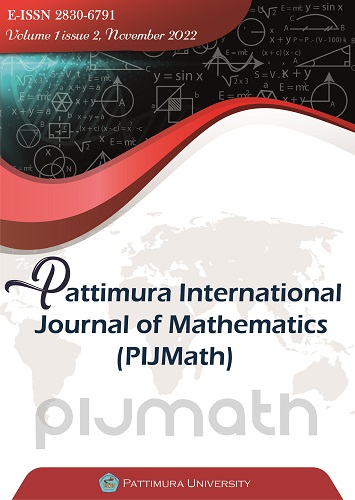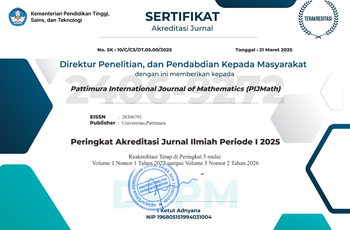Forecasting The Composite Stock Price Index Using Autoregressive Integrated Moving Average Hybrid Model Artificial Neural Network
Abstract
A stock index is a statistical measure that reflects the overall price movement of a group of stocks selected based on certain criteria and methodologies and evaluated regularly. JCI is included in the composite index, which is the Headline index. The Headline Index is an index that is used as the main reference to describe the performance of the capital market. The JCI is very important in describing the current condition of the capital market because the JCI measures the price performance of all stocks listed on the Main Board and Development Board of the IDX. This study aims to predict JCI data using the time series method. The hybrid Autoregressive Integrated Moving Average–Artificial Neural Network (ARIMA-ANN) model combines the linear ARIMA model and the non-linear ANN model. The best models are the ARIMA model (2,1,1) and the ANN Backpropagation model with one input layer, one hidden layer with 20 neurons, and one output. The ARIMA-ANN hybrid model accurately predicts JCI data because it produces a MAPE value of less than 1%, with the level of forecasting accuracy from testing results being smaller than the level of accuracy during training. In addition, the forecast for the next five days is very accurate because it produces a very small RMSE and a MAPE below 1%, respectively, namely 56.99 and 0.72%.
Downloads
References
Indonesia Stock Exchange, “Bagaimana Menjadi Investor Saham,” [“How to Become a Stock Investor”] Jakarta, 2015. Accessed: Sep. 07, 2022. [Online]. Available: https://www.idx.co.id/Portals/0/StaticData/Information/ForInvestor/HowToBecomeAnInvestor/HTBAI-Ind-2015.pdf
Indonesia Stock Exchange, “IDX Stock Index Handbook v1.2,” Jakarta, Jan. 2021. Accessed: Sep. 07, 2022. [Online]. Available: https://www.idx.co.id/media/9816/idx-stock-index-handbook-v12-_-januari-2021.pdf
Indonesia Stock Exchange, “IDX Fact Book 2019,” Jakarta, 2019. [Online]. Available: www.idx.co.id
E. Fauziyah, D. Ispriyanti, and T. Tarno, “PEMODELAN DAN PERAMALAN INDEKS HARGA SAHAM GABUNGAN (IHSG) MENGGUNAKAN ARIMAX-TARCH,” ["MODELING AND FORECASTING THE JOINT STOCK PRICE INDEX (JCI) USING ARIMAX-TARCH"] Jurnal Gaussian, vol. 10, no. 4, pp. 595–604, Dec. 2021, doi: 10.14710/j.gauss.v10i4.33102.
P. Pardede, “PENERAPAN MODEL ARIMA DALAM MEMPREDIKSI INDEKS HARGA SAHAM GABUNGAN BURSA EFEK INDONESIA-JAKARTA,” ["APPLICATION OF THE ARIMA MODEL IN PREDICTING THE INDONESIA-JAKARTA JOINT STOCK PRICE INDEX"] Jurnal Penelitian Manajemen, vol. 1, no. 1, pp. 92–103, 2019, Accessed: Sep. 08, 2022. [Online]. Available: http://ojs.mputantular.ac.id/index.php/MPU/article/view/194/159
R. Susanti and A. R. Adji, “ANALISIS PERAMALAN IHSG DENGAN TIME SERIES MODELING ARIMA,” ["JCI FORECASTING ANALYSIS WITH ARIMA TIME SERIES MODELING"] Jurnal Manajemen Kewirausahaan, vol. 17, no. 1, pp. 97–106, Jun. 2020, doi: 10.33370/jmk.v17i1.393.
D. Gunawan and W. Astika, “The Autoregressive Integrated Moving Average (ARIMA) Model for Predicting Jakarta Composite Index,” Jurnal Informatika Ekonomi Bisnis, vol. 4, no. 1, pp. 1–6, Feb. 2022, doi: 10.37034/infeb.v4i1.114.
J. du Preez and S. F. Witt, “Univariate versus multivariate time series forecasting: an application to international tourism demand,” Int J Forecast, vol. 19, no. 3, pp. 435–451, Jul. 2003, doi: 10.1016/S0169-2070(02)00057-2.
I. A. Iwok and A. S. Okpe, “A Comparative Study between Univariate and Multivariate Linear Stationary Time Series Models,” American Journal of Mathematics and Statistics, vol. 6, no. 5, pp. 203–212, 2016, doi: 10.5923/j.ajms.20160605.02.
D. Oktasari, “Perbandingan Model ARIMA Univariat dengan Multivariat Untuk Menduga Pola Absorbsi pada Stronsium Titanat Variasi Dop,” ["Comparison of Univariate and Multivariate ARIMA Models to Predict Absorption Patterns in Strontium Titanate Dop Variations"] Bogor Agricultural University (IPB), Bogor, 2018.
A. Santoso and S. Hansun, “Prediksi IHSG dengan Backpropagation Neural Network,” ["JCI Prediction with Backpropagation Neural Network"] Jurnal RESTI (Rekayasa Sistem dan Teknologi Informasi), vol. 3, pp. 313–318, Aug. 2019, doi: 10.29207/resti.v3i2.887.
I. Halimi and W. A. Kusuma, “Prediksi Indeks Harga Saham Gabungan (IHSG) Menggunakan Algoritma Neural Network,” ["Prediction of the Composite Stock Price Index (JCI) Using the Neural Network Algorithm"] Jurnal Edukasi dan Penelitian Informatika (JEPIN), vol. 4, no. 1, pp. 24–29, Jun. 2018, doi: 10.26418/jp.v4i1.25384.
G. P. Zhang, “Time series forecasting using a hybrid ARIMA and neural network model,” Neurocomputing, vol. 50, pp. 159–175, Jan. 2003, doi: 10.1016/S0925-2312(01)00702-0.
L. Wang, H. Zou, J. Su, L. Li, and S. Chaudhry, “An ARIMA-ANN Hybrid Model for Time Series Forecasting,” Syst Res Behav Sci, vol. 30, no. 3, pp. 244–259, May 2013, doi: 10.1002/sres.2179.
B. A. Safitri, A. Iriany, and N. W. S. Wardhani, “Perbandingan Akurasi Peramalan Curah Hujan dengan menggunakan ARIMA, Hybrid ARIMA-NN, dan FFNN di Kabupaten Malang,” ["Comparison of Rainfall Forecasting Accuracy using ARIMA, Hybrid ARIMA-NN, and FFNN in Malang Regency"] in Seminar Nasional Official Statistics, Sep. 2021, pp. 245–253. doi: 10.34123/semnasoffstat.v2021i1.853.
Y. Susanto and B. S. S. Ulama, “Pemodelan Curah Hujan dengan Pendekatan Model ARIMA, Feed Forward Neural Network dan Hybrid (ARIMA-NN) di Banyuwangi,” ["Rainfall Modeling with ARIMA Model Approach, Feed Forward Neural Network and Hybrid (ARIMA-NN) in Banyuwangi"] JURNAL SAINS DAN SENI ITS, vol. 5, no. 2, 2016, doi: 10.12962/j23373520.v5i2.16409.
K. Naveena, S. Singh, S. Rathod, and A. Singh, “Hybrid ARIMA-ANN Modelling for Forecasting the Price of Robusta Coffee in India,” Int J Curr Microbiol Appl Sci, vol. 6, no. 7, pp. 1721–1726, Jun. 2017, doi: 10.20546/ijcmas.2017.607.207.
W. S, “Prediksi Inflasi Indonesia Memakai Model ARIMA dan Artificial Neural Network,” ["Indonesia's Inflation Prediction Using the ARIMA Model and Artificial Neural Network"] Jurnal Tata Kelola dan Kerangka Kerja Teknologi Informasi, vol. 5, no. 1, Jan. 2019, doi: 10.34010/jtk3ti.v5i1.2297.
I. K. Hasan and Ismail Djakaria, “Perbandingan Model Hybrid ARIMA-NN dan Hybrid ARIMA-GARCH untuk Peramalan Data Nilai Tukar Petani di Provinsi Gorontalo,” ["Comparison of Hybrid ARIMA-NN and ARIMA-GARCH Hybrid Models for Forecasting Farmers' Exchange Rate Data in Gorontalo Province"] Jurnal Statistika dan Aplikasinya, vol. 5, no. 2, pp. 155–165, Dec. 2021, doi: 10.21009/JSA.05204.
C. Y. Rumaruson, L. J. Sinay, and M. I. Tilukay, “Indonesian rupiah exchange rate prediction using a hybrid ARIMA and neural network model,” in AIP Conference Proceedings, Nov. 2021, p. 020007. doi: 10.1063/5.0059512.
R. L. Fraiha Lopes, S. G. C. Fraiha, H. S. Gomes, V. D. Lima, and G. P. S. Cavalcante, “Application of Hybrid ARIMA and Artificial Neural Network Modelling for Electromagnetic Propagation: An Alternative to the Least Squares Method and ITU Recommendation P.1546-5 for Amazon Urbanized Cities,” Int J Antennas Propag, vol. 2020, pp. 1–12, Mar. 2020, doi: 10.1155/2020/8494185.
G. E. P. Box and G. M. Jenkins, Time Series Analysis: Forecasting and Control, Rev. San Francisco: Holden-Day, 1976.
L. J. Sinay, F. K. Lembang, S. N. Aulele, and D. Mustamu, “Analisis Curah Hujan Bulanan di Kota Ambon menggunakan Model Heteroskedastisitas: SARIMA-GARCH,” ["Analysis of Monthly Rainfall in Ambon City using the Heteroscedasticity Model: SARIMA-GARCH"] MEDIA STATISTIKA, vol. 13, no. 1, pp. 68–79, Jun. 2020, doi: 10.14710/medstat.13.1.68-79.
D. Kwiatkowski, P. C. B. Phillips, P. Schmidt, and Y. Shin, “Testing the null hypothesis of stationarity against the alternative of a unit root,” J Econom, vol. 54, no. 1–3, pp. 159–178, Oct. 1992, doi: 10.1016/0304-4076(92)90104-Y.
H. Akaike, “Information Theory and an Extension of the Maximum Likelihood Principle,” in Proceedings of the 2nd International Symposium on Information Theory, 1973, pp. 267–281.
W. S. Mcculloch and W. Pitts, “A LOGICAL CALCULUS OF THE IDEAS IMMANENT IN NERVOUS ACTIVITY,” 1990.
P. J. Werbos, “Beyond regression : new tools for prediction and analysis in the behavioral sciences,” Harvard University, Massachusetts, 1974.
P. J. Werbos, “Backpropagation through time: what it does and how to do it,” Proceedings of the IEEE, vol. 78, no. 10, pp. 1550–1560, 1990, doi: 10.1109/5.58337.
K. Fukushima, “Cognitron: A self-organizing multilayered neural network,” Biol Cybern, vol. 20, no. 3–4, pp. 121–136, 1975, doi: 10.1007/BF00342633.
F. Günther and S. Fritsch, “neuralnet: Training of Neural Networks,” R J, vol. 2, no. 1, p. 30, 2010, doi: 10.32614/RJ-2010-006.
N. D. Lewis, “BUILD YOUR OWN NEURAL NETWORK TODAY!,” 2015.
Yahoo Finance, “Jakarta Composite Index (JKSE),” https://finance.yahoo.com/quote/%5EJKSE/history?period1=1514851200&period2=1648684800&interval=1d&filter=history&frequency=1d&includeAdjustedClose=true, Mar. 2022. https://finance.yahoo.com/quote/%5EJKSE/history?period1=1514851200&period2=1648684800&interval=1d&filter=history&frequency=1d&includeAdjustedClose=true (accessed Mar. 01, 2022).
Copyright (c) 2022 Lexy Janzen Sinay, Muhidin Jaariyah, Norisca Lewaherilla, Yopi Andry Lesnussa

This work is licensed under a Creative Commons Attribution-NonCommercial 4.0 International License.
The author(s) hold the copyright of the published article without restriction. This policy means that the journal allows the author(s) to hold and retain publishing rights without restrictions.
The author(s) holds the copyright of published articles without limitation. This policy means that the journal allows the author to hold and retain publishing rights without restrictions. Journal editors are given the copyright to publish articles in according to agreement signed by the author and also include statement of originality of the article


.jpg)












 This work is licensed under a
This work is licensed under a 